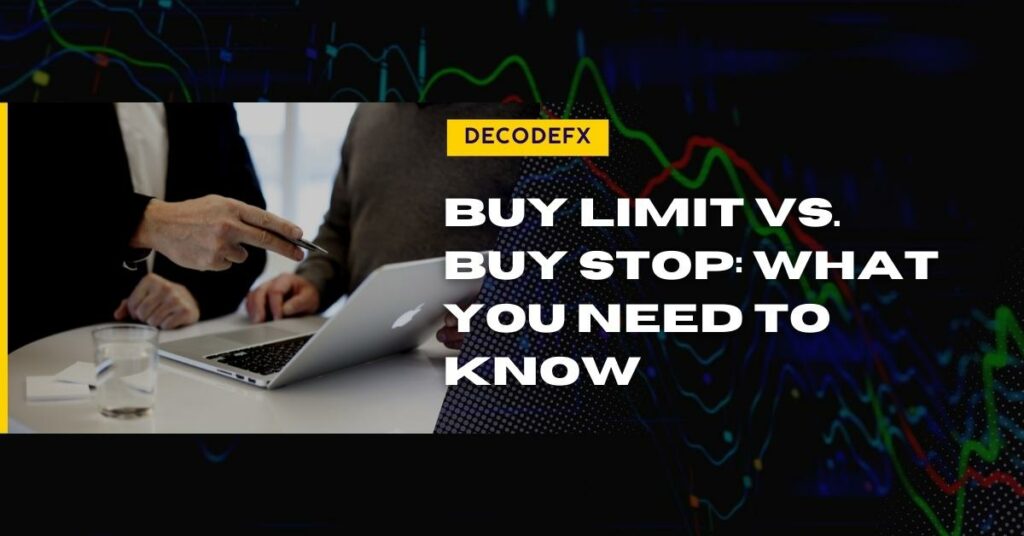When participating in Forex trading, there are two ways to enter or exit a trade: through a market order or a pending order. A market order is an order that is executed immediately at the current market price. On the other hand, a pending order is executed only when the market price reaches a certain level. There are four types of pending orders: buy limit, sell limit, buy stop and sell stop. If you’re new to Forex trading, you might be wondering what buy limits and buy stops are. In this article, we’ll explain the differences between these two types of orders and show you when to use each one.
How do people participate in Forex trading?
Forex trading is the act of buying and selling currencies. The aim is to make a profit by buying and selling currencies in pairs. For example, if you think that the US dollar will rise against the euro, you would buy USD/EUR. If your prediction turns out to be correct, you will make a profit.
What do buy limits mean in Forex trading?
Buy limits are used to buy a currency pair at a lower price than the current market price. For example, let’s say that you think the EUR/USD currency pair is going to go up in value. The current market price is 1.10, but you think it will reach 1.15 in the next few hours. In order to make a profit, you would need to buy the currency pair at 1.10 and then sell it when it reaches 1.15. However, if you place a buy limit order at 1.09, your trade will only be executed if the market price falls to 1.09 or below. Your trade will not be executed if the market price doesn’t fall to 1.09.
What do buy stops mean in Forex trading?
Buy stops are used to buy a currency pair at a higher price than the current market price. For example, let’s say that you think the EUR/USD currency pair is going to fall in value. The current market price is 1.10, but you think it will reach 1.05 in the next few hours. In order to make a profit, you would need to sell the currency pair at 1.10 and then buy it back when it reaches 1.05. However, if you place a buy stop order at 1.11, your trade will only be executed if the market price rises to 1.11 or above. If the market price doesn’t rise to 1.11, your trade will not be executed.
A Comparative Guide of Buy Limit Vs. Buy Stop Forex Orders
1. Time of Use
You can place a buy limit order if you have reasons to believe that the market price of a currency pair will fall to a certain level and then start to rise again. You would place a buy stop order if you believe that the market price of a currency pair will rise to a certain level and then start to fall again. This is because a buy limit order will only be executed at the price you specify or lower, while a buy stop order will only be executed at the price you specify or higher.
2. Entry Price
The entry price is the price at which your trade will be executed. With a buy limit order, you specify the entry price as being lower than the current market price. This means that you will only make a profit if the market price falls to your specified level and then starts to rise again. With a buy stop order, you specify the entry price as being higher than the current market price. This means that you will only make a profit if the market price rises to your specified level and then starts to fall again.
3. Stop Loss Placement
While using buy limit orders, your stop loss would be placed at a price level that is lower than your entry price. Conversely, when using buy stop orders, your stop loss would be placed at a level that is higher than your entry price.
4. Profit Target Placement
Your profit target would be placed at a price level that is higher than your entry price when using buy limit orders. When using buy stop orders, your profit target would be placed at a level that is lower than your entry price.
Which is better to use, buy stop or buy limit?
Well, this depends on your trading strategy and the market conditions. If you think that the market price of a currency pair is going to fall and then start to rise again, you would use a buy limit order. If you think that the market price of a currency pair is going to rise and then start to fall again, you would use a buy stop order. Ultimately, it is up to you to decide which type of order to use.
Four Factors to Look Out For With Forex Buy Limits and Stops
While buy limit and buy stop orders can be beneficial, there are also some factors that you need to look out for.
1. The market trend
The market trend is the overall direction that the market is moving in. You need to be aware of the market trend before placing a buy limit or buy stop order. If the market trend is going up, it is more likely that a buy stop order will be executed than a buy limit order. Likewise, if the market trend is going down, it is more likely that a buy limit order will be executed than a buy stop order.
2. Slippage
Slippage is when your trade is executed at a price that is different from the price you specified. Slippage can occur with both buy limit and buy stop orders. It is important to take slippage into account when placing your orders because it can eat into your profits.
Related: A Guide on Looking Out for Slippages in Forex
3. Reversals
A reversal is when the market trend changes direction. Reversals can occur suddenly and without warning. If a reversal occurs, it is possible that your buy limit or buy stop order will not be executed.
4. Spread
The spread is the difference between a currency pair’s bid and ask price. The spread can widen or narrow depending on market conditions. A widening spread can eat into your profits or even cause you to make a loss. In most cases, the spread can influence slippage. For example, if the spread is wide, there is a greater chance that your trade will be executed at a worse price than you specified.
5. Volatility
Volatility is the amount of price movement in a given period of time. The forex market is typically more volatile during certain times of the day or week. If you place a buy limit or buy stop order during a period of high volatility, there is a greater chance that it will be executed at a worse price than you specified.
4 Other Types of Forex Orders People Use in Trading
In addition to buy limit and buy stop orders, there are four other types of orders that people use in forex trading.
1. Stop Loss
A stop loss order is an order to sell a currency pair when it reaches a certain price. The purpose of a stop loss order is to limit your losses if the market price moves against you. For example, if you buy EUR/USD at 1.1500 and place a stop loss order at 1.1450, your trade will be closed automatically if the market price falls to 1.1450.
2. Take Profit
A take profit order is an order to sell a currency pair when it reaches a certain price. The purpose of a take profit order is to take profits when the market price moves in your favour. For example, if you buy EUR/USD at 1.1500 and place a take profit order at 1.1550, your trade will be closed automatically if the market price rises to 1.1550.
3. Sell Limit
A sell limit order is an order to sell a currency pair when it reaches a certain price. A sell limit order aims to take profits when the market price is expected to rise. For example, if you think that EUR/USD will rise to 1.1600, you could place a sell limit order at 1.1600. Your trade would then be executed automatically if the market price rises to 1.1600.
4. Sell Stop
A sell stop order is an order to sell a currency pair when it reaches a certain price. The purpose of a sell stop order is to limit your losses if the market price is expected to fall. For example, if you think that EUR/USD will fall to 1.1400, you could place a sell stop order at 1.1400. Your trade would then be executed automatically if the market price falls to 1.1400.
Conclusion
Ultimately, the decision of whether to place a buy limit or buy stop order comes down to your trading strategy and the market conditions at the time. While there are no hard and fast rules, as a general rule of thumb, if you think the market is going to move in your favor, you would place a buy stop order. If you think the market is going to move against you, you will place a buy limit order.
Visit Decode Global and find out more about Forex buy limits and stops
Now that you know how pending orders work, take advantage of them by signing up on a forex trading platform. Decode Global provides you with ultra-low spreads and excellent trading conditions to make sure your trade orders are filled efficiently. Signup today.

